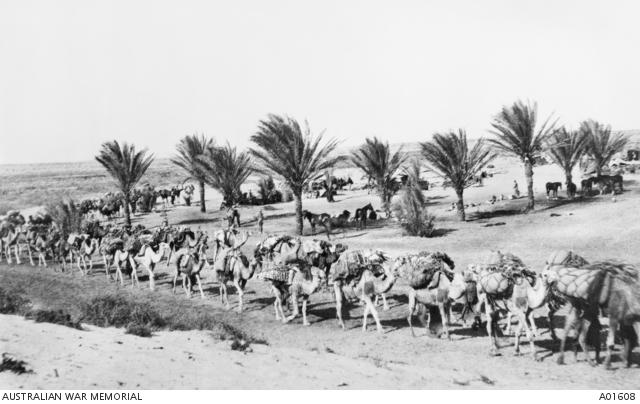The Imperial Camel Corps
In this WW1 themed sound reel four Australian men voice their experiences of the Imperial Camel Corps.
After Australian troops withdrew from Gallipoli in December 1915, the Ottoman Empire persuaded the pro-Turkish Senussi tribesmen to attack British-occupied Egypt. In January 1916, a Desert Mounted Corps was formed to deal with the revolt. The Imperial Camel Corps formed four battalions: the 1st Battalion was entirely Australian, the 2nd Battalion was British, and the 3rd and 4th Battalions were a mix of Australians and New Zealanders. There was also a machine gun unit, and a battery of light artillery recruited from Hong Kong and Singapore.
From 1917 to 1918 the Camel Corps advanced north through Palestine and were a part of the attack on Beersheba, and the battles of Magdhaba, Romani, Gaza and Rafa. The Camel Corps were notorious as rough men of less than desirable character, as a young private George Jones discovered when he moved from the Camel Corps to the Flying Corps; his new colleagues were far less tolerant of colourful language than he. Regardless of this the men of the Camel Corps proved themselves to be inventive and effective in battle. The heavy losses suffered by the Camel Corps at the second battle of Gaza are recalled by William Logan, while Edward Duncan describes the difficulties of the 5th Camel Brigade Field Ambulance, and the agony suffered by the wounded that were transported by camel.
The Camel Corps was also an opportunity for Indigenous Australians to participate in mounted warfare, as many were turned away from the Light Horse. The Camel Corps was disbanded in June 1918, and the Australians were used to form the 14th and 15th Light Horse Regiments.

Camel lines carrying stores. A01608
Sound
- Oral history with Brigadier John McNeil, http://www.awm.gov.au/collection/S00186/
- Oral history with Air Marshal Sir George Jones KBE CB DFC http://www.awm.gov.au/collection/S00381/
- Oral history with Edward S. Duncan http://www.awm.gov.au/collection/S02039/
- Oral history with William 'Bill' Alexander Logan http://www.awm.gov.au/collection/S04976/
Film
Photographs
- http://www.awm.gov.au/collection/A01608/
- http://www.awm.gov.au/collection/H00774/
- http://www.awm.gov.au/collection/013045/
- http://www.awm.gov.au/collection/H03834/
- http://www.awm.gov.au/collection/H02464/
- http://www.awm.gov.au/collection/P03631.002/
- http://www.awm.gov.au/collection/J02884/
- http://www.awm.gov.au/collection/B02848/
- http://www.awm.gov.au/collection/B01464/
- http://www.awm.gov.au/collection/B01464/
- http://www.awm.gov.au/collection/B01548/
- http://www.awm.gov.au/collection/H11643/
- http://www.awm.gov.au/collection/B01549/